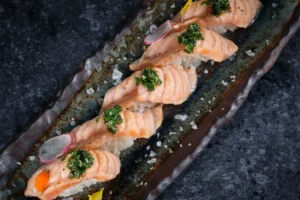The Art of Sushi Making
Sushi, the mere mention of it conjures images of delicate bites, vibrant colours, and an explosion of flavours. But this popular Japanese dish is more than just a meal; it’s a culinary art form steeped in tradition, precision, and meticulous dedication. Today, we delve into the world of sushi making, unveiling the artistry behind each exquisite piece.
The Canvas: Rice, the Soul of Sushi
The foundation of any great sushi lies in its rice. Not just any rice, mind you, but specially cultivated short-grain varieties like Koshihikari or Akita Komachi. These are meticulously washed, soaked, and cooked following precise methods to achieve the perfect texture: slightly sticky, yet individual grains remain distinct. Seasoning with a blend of rice vinegar, sugar, and salt imbues the rice with a subtle sweetness and tang, balancing the flavours to come.
The Brushstrokes: Knife Skills and Precision
A sushi chef’s knife is an extension of their artistry. Years of dedicated practice hone their skills, transforming them into masters of precision. Each fish slice boasts a smooth, clean surface, revealing the vibrant hues and delicate marbling within. Razor-sharp cuts ensure optimal texture and minimal waste, a testament to the respect for both the ingredient and the craft.
The Palette: A Symphony of Ingredients
Beyond the iconic tuna and salmon, the sushi chef’s palette encompasses a vast array of ingredients. Each selection is chosen with utmost care, considering seasonality, freshness, and flavour profile. Fatty cuts of tuna melt on the tongue, while lean whitefish offers a refreshing contrast. Eels are glazed to perfection, delivering a sweet and savoury dance. Even the seaweed wrapper, nori, is carefully toasted to release its umami-rich aroma.
The Composition: Mastering the Art of Form
From the simple elegance of nigiri to the intricate rolls of uramaki, each type of sushi showcases a unique composition. Nigiri, with its hand-moulded rice base topped with a glistening slice of fish, is a study in minimalism. Uramaki, with its layers of contrasting flavours and textures encased in seaweed and rice, is a testament to creativity. Each piece is arranged with intention, ensuring a visually pleasing and balanced bite.
The Garnish: Adding the Finishing Touches
Just like a painter wouldn’t leave their canvas bare, a sushi chef doesn’t neglect the final touches. A dab of wasabi adds a subtle heat, while pickled ginger cleanses the palate between bites. Shiso leaves bring a touch of herbal freshness, and tobiko (flying fish roe) adds a delightful burst of texture and briny flavour. Each element is meticulously placed, transforming the sushi into a miniature work of art.
The Master’s Touch: The Importance of Experience
Years of apprenticeship under a seasoned sushi chef are crucial. Not only does it refine knife skills and perfect rice preparation, but it instils a deep understanding of flavour profiles and ingredient selection. The ability to balance textures, adjust seasoning, and adapt to the nuances of each ingredient elevates sushi making from mere technique to an art form.
Beyond the Plate: A Cultural Experience
Sushi is more than just food; it’s an embodiment of Japanese culture. The emphasis on seasonality reflects a deep respect for nature’s bounty. The meticulous preparation underscores the value of precision and dedication. And the communal act of sharing sushi fosters connection and appreciation for this culinary art form.
So, the next time you savour a piece of sushi, take a moment to appreciate the artistry behind it. From the meticulously prepared rice to the perfectly sliced fish, each bite is a testament to the dedication, skill, and cultural heritage that defines the art of sushi making. It’s an experience that goes beyond the taste buds, offering a glimpse into the heart of Japan’s culinary soul.


